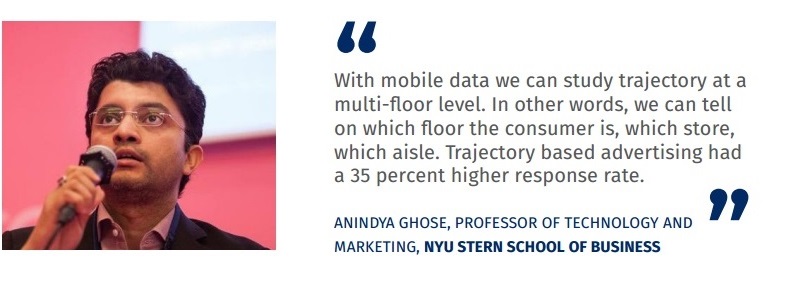In this issue of #highondata Anindya Ghose, Professor of Information Technology and Marketing and Director, Center for Business Analytics at NYU Stern talks about how mobile data is helping companies target consumers at a very granular level.
Mobile advertising has a reputation of being difficult, from an execution perspective, and ineffective. What is your take on this?
Mobile as a channel has its own challenges just like any other channel. Yes, you often hear marketers say mobile doesn’t really work. Those who say so are misguided. My years of study in data science has taught me that identifying the right metric is key to understand advertising effectiveness and audience behavior. While conversions on mobile devices might only be about 1 percent, the actual extent of influence can be around 20 percent. What this means is that while people might not be clicking on an ad and proceeding to buy a product or service right away, the influence that ad has on their final decision is higher than many other channels.
It’s a myth that consumers hate ads. That’s not true at all. If the ad is relevant, you will see the enormous amount of traction mobile can have. It is also a myth that consumers do not want to share their personal information with firms. People are willing to exchange their information with businesses in exchange for relevant value. In my academic studies and industry consulting engagements, I have worked with companies not only in the US but also in Germany, China and South Korea on measuring the effectiveness of mobile advertising and mobile marketing. If firms can do a better job in extracting consumer preferences and use that information effectively for targeting, they will be surprised to find how receptive consumers are when they receive such relevant ads and offers.
Consumers spend about 24 percent of their time on their mobile device, but only 8 percent of marketing
dollars are being spent on mobile advertising as of 2015. Even though the gap has been shrinking, it raises the question about why it hasn’t been faster. There is a massive untapped potential for monetization in the mobile economy.
That said, in the U.S. alone, mobile ad spends amounted to $25 billion last year. When we look at the next five big countries – India, China, South Korea, Germany and Brazil – the figure goes up to more than $100 billion dollars. So this is a significant medium in which marketers must focus more resources.
I have a forthcoming book on this topic that is being published by MIT Press. It is called TAP: Forces Shaping The Mobile Economy. The insights in this book will empower you to tap into unprecedented opportunities that are headed our way in the mobile economy and resolve several behavioral contradictions displayed by consumers, and give new insights to readers.
What are some of the most common ways marketers are using mobile data today?
Mobile devices create a great trail of data, the most important of which is geolocation. We’ve
come a long way in terms of the accuracy and granularity of this data.
Mobile coupons are usually a great way to get customers’ attention. Early applications of mobile data included geo-targeting based campaigns. Geo-targeting is basically an artificial periphery created by stores often based on distance. When a consumer enters within a specific distance of the store, they are served mobile coupons.
Some marketers have also used what we call geo-conquesting effectively – that’s when you poach a
competitor’s customer if data shows them walking into a competitor’s store.
What is the rate of redemption of these coupons? How successful are they?
Let me give you an example. In Germany, I worked with a consortium of retailers, application
platform developers, aggregators and telecom service providers. We were looking to create a Yelp-like app for mobile coupon offers. What we learned here is that when you vary discounts based on the distance a consumer is away from the store, it leads to an additional 3 percent conversion rate. So basically, the further a consumer is from your store, the greater the required ‘push’ to visit your store. You need to give them a better offer than a consumer who just happens to be out in public. In shopping malls in Asia, we have seen redemption rates up to 30 percent when we have used highly granular targeting based on customer shopping trajectories.
Are there any consumer behavioral indicators that influence the success of coupon redemption?
Yes, there are many. I’ll give you a few examples. In Korea, we wanted to understand if travel patterns
influence mobile coupon redemption. Let’s say there are two routes – there is a standard commute route a person takes, say home-work-gym-home. And a few days a week there is a deviant commute route. Maybe
they go to meet friends for a drink or dinner two days a week. Which of these two routes are they more likely to redeem their mobile coupon on? We found that the mean of a user’s commuting pattern is 1.9 times a stronger predictor of their mobile commerce activities compared to the variance. In this case, they were more likely to redeem their coupon during a standard commute day. So, if we know this and we know which areas are going to get the most traffic, can Out-of-Home (OOH) advertising be synergized with mobile? The answer is of course it can and when that is done, there is a significant increase in coupon redemption.
In a subway system in China, we studied the effect of crowds on coupon redemption. We found that an
increase in the number of people per square mile in a subway saw an increase in redemption rates.
In the last year, we have seen tremendous advancements in technology. Data from Beacons, for example, have allowed companies to map consumer movement in-store, even down to the aisles they browse. You spoke about some of the cutting-edge applications of this data at LatentView Analytics’ most recent Roundtable in Chicago. Can you tell us how this granularity of data has catapulted the success of mobile coupon redemption?
Yes – with Beacons and increased Wi-Fi connectivity, we are able to move from macro location targeting to in-store and more context-based targeting. In essence, what they do provide us is with a trajectory the consumer is on instead of just static data. That is immensely valuable.
Let me give you an example, one of the many interesting consumer insights derived from real world studies that I feature in my forthcoming book, TAP.
In a project I did for one of the largest shopping malls in the world – 1.3 million square feet, 300 stores, 100,000 visitors per day (200,000 visitors per day during holidays) – we were able to study trajectory at a multi-floor level. In other words, we were able to tell on which floor the consumer is, which store, which aisle. What we found was that trajectory based advertising had a 35 percent higher response rate and 3 times faster redemption than location-based advertising. But this was only on weekdays. On weekends, random targeting was more effective. We also found that large groups of three or more people were more likely to respond to a mobile coupon that individual shoppers. Couples were the least responsive.
We also uncovered some very interesting behavioral patterns. For example, we found that people from higher income groups were unlikely to shop in larger groups. Men were more likely to shop alone than women. There is a strong social and cultural influence when it comes to shopping and so these will vary from marketto market.
Mobile analytics can provide some very deep insights into shopping behavior, so it’s an exciting time
for data science and how companies use the data that is available to them.
All this and many other interesting consumer insights derived from real world studies across the world, are part of my forthcoming book, TAP.
You may also find it interesting to read our blog article on how to use mobile payment data to shape your business or how the CPG industry is using mobile & social media data.




